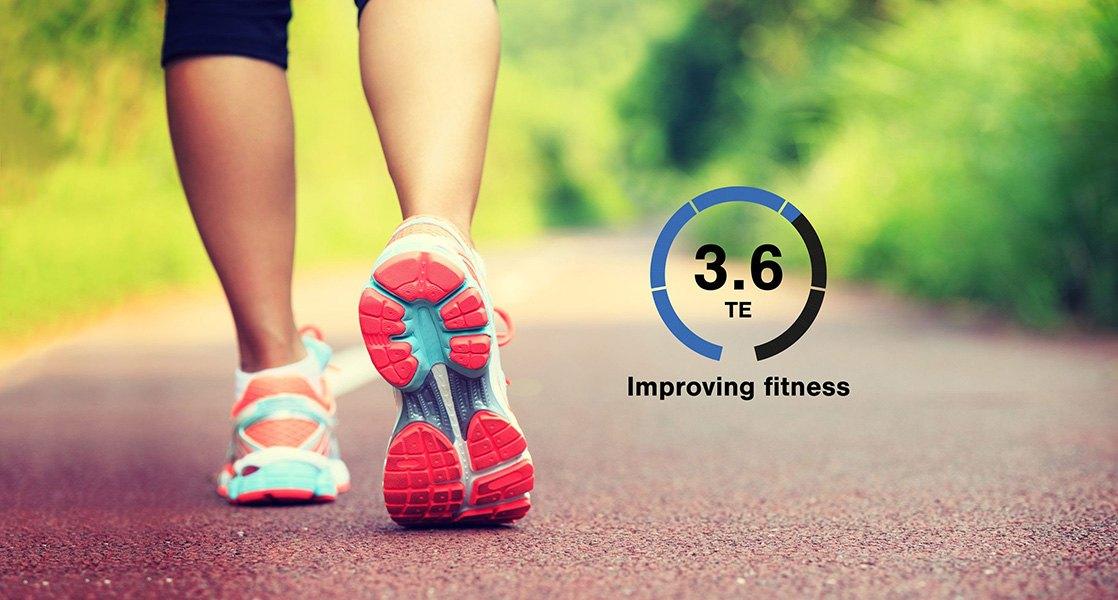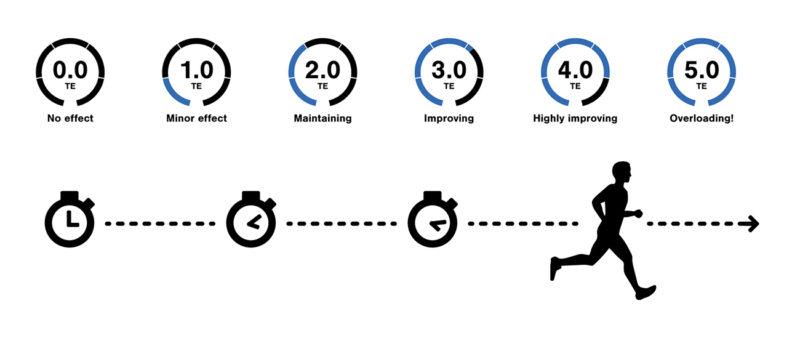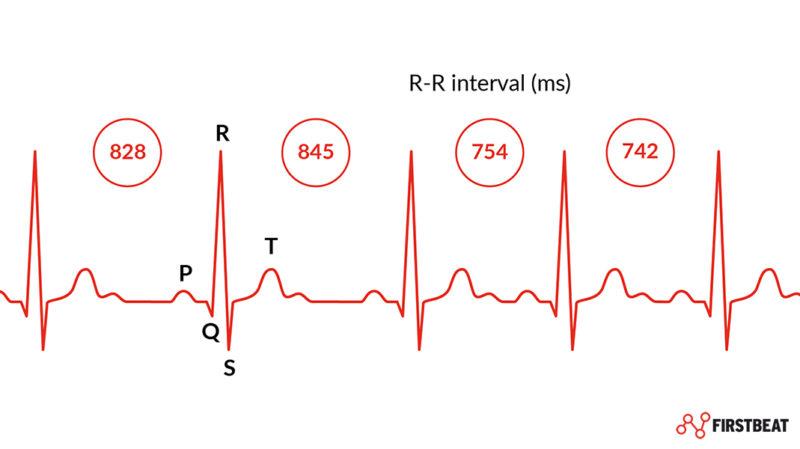
Train Smart with Firstbeat. Do you want to get most out of your training? In this blog series we help you to understand the physiological background of Firstbeat features and how to use them to improve your fitness and achieve your performance goals.
It’s easy to track the miles you run, the hours you cycle and the calories you burn. You can even check your heart rate along the way. But how do you know if your efforts are taking you in the right direction?
The answer lies in your ability to understand and utilize your Training Effect feedback.
Whether your goal is to recover better, improve or maintain your current fitness level, it’s vital to know how your workouts influence your body. The relationship between activity and outcome isn’t always the same. Similar runs can produce different results depending on your Fitness Level, training history, and even your training environment.
If you are already quite fit, a 30-minute 5k run is a good warm up. As a novice, it might knock your socks off.
Firstbeat’s Aerobic Training Effect combines cutting-edge sports science and analytics to connect the dots between your activities and how your body will respond. It describes how your training session is expected to affect your aerobic fitness level, that is your VO2max. Is it improving or maintaining it – are you promoting recovery – or having no effect at all?

The scale for Aerobic Training Effect goes from 0.0 to 5.0, where 0.0 means that training session has no aerobic impact on your body and 5.0 indicates overload. Generally, you should avoid overloading, and extreme efforts require special attention to recovery. (Click to enlarge)
The scale of Aerobic Training Effect (TE) goes from 0.0 to 5.0, where 0.0 means “no effect” and 5.0 is “overloading.” Beat your personal best in a 5k race, you probably get a Training Effect of 4-5 (“highly improving” or “overloading”). And if you are able to chit-chat incessantly with your friend during a bicycle ride, your Training Effect will probably be 1.0-2.5 (“minor effect” or “maintaining”).
Effective Training Means Variation
Bigger is better – right? Not necessarily.
Of course, to boost your aerobic fitness, you need to challenge yourself. You need to push your limits and get totally out of breath. Only this way you will get Aerobic Training Effect of 3.0-5.0, which means that your body is loaded harder than it is accustomed, which in turn is necessary for improvement.
But you need lot more than just hard and challenging exercises to improve your fitness, to avoid overtraining and to stay healthy. Your exercise can be very useful, although your Training Effect value isn’t that high. Long, easy efforts don’t improve your VO2max directly, but they build the firm endurance base that is essential while doing high-intensity exercises.
Have you wondered why your multi-hour bicycle ride or hiking trip produced a low Aerobic Training Effect – even though you feel exhausted and totally out of energy? It’s because the intensity might be too low for improvement of VO2max, but just right for building an endurance base.
Hard Work Pays Off When Resting
Low-intensity activities are also a great way to enhance your recovery – an essential part of any training program.
It’s during your recovery time that your hard work actually pays off. Your body adapts in response to your efforts and improvements happen. However, a rest day doesn’t mean that you need to lie on the couch all day. On a rest day, it is good to go for a walk, take an easy bike ride or do some stretching.

Successful training programs include both improving and maintaining exercises, and enough rest and recovery.
Simply keep an eye on your Aerobic Training Effect and try to avoid going above 2.0.
Remember, Aerobic Training Effect is specifically describing the impact of your efforts on the development of your aerobic fitness, that is VO2max. Of course, there are also many other factors that affect your performance, fitness, and well-being, like muscle strength, economy of movement and anaerobic fitness. Interested in learning how to improve your anaerobic performance capacity? Check out our Anaerobic Training Effect.
The only way to improve these diverse aspects of performance is to vary the focus of your activities. This variation is essential to becoming a well-rounded performer, and to find the right workout at the right time. It is important to understand the impact and role of each workout in your repertoire
Fitter Need to Work Harder
When deciding how hard you should train, it is the goal that matters. Are you on a mission to boost your VO2max to the Superior level, or simply eager to feel healthy and energetic? The more ambitious your goals, the greater the intensity and the overall amount of exercise must be.
Without additional challenges body adapts to the current level, and you’ll plateau.
This is also the reason why the improvement of fitness is fastest for the beginners. The fitter you get, the more effort it takes to get results. Luckily, the feedback you get from Aerobic Training Effect keeps up with your development to ensure personalized analysis based on your current fitness level and training history.
For example, if you’re out of shape, it might take 40 minutes to finish a 5k run with an Aerobic Training Effect of 3.2 (improving). If you then train wisely, you may finish the same 5k run in 30 minutes – with TE of 2.5 (maintaining). Congratulations! Your aerobic fitness has improved, and you need to run even faster to further improve your VO2max.
It’s All about EPOC
Last but not least, few words about the physiology of Aerobic Training Effect. The basis lies behind EPOC, a physiological measure that reflects the recovery demand of your body. It stands for Excess Post-Exercise Oxygen Consumption and tells how much oxygen – used at a cellular level to convert nutrients into energy – your body needs to restore itself and adapt in response to your efforts.
EPOC is a measure of the work your body does to prepare for the next challenge. The harder the exercise, the more energy your body expends to recover, the higher your EPOC – and the higher your Aerobic Training Effect.
Traditionally EPOC has been measured in laboratories, but for well over a decade, Firstbeat has been pioneering the ability to predict EPOC values using heartbeat data. This valuable insight is calculated in real time which allows you to see the impact of your activity – that is your Aerobic Training Effect – accumulate and adjust as you go. You can either speed up or slow down based on the feedback and achieve your training goals smarter than before.
You might also be interested in

Intensity Is Your Fitness Friend
You may have heard that your fitness level is determined by your genetics. This is true. Luckily, that’s not the whole story. Experts say that about half of the variation in physical fitness between individuals is heritable, meaning it comes to you through your parents.

5 Reasons to Boost your VO2max
Results matter. In terms of understanding whether your activity and lifestyle profile translates into real health benefits, VO2max – the defining metric of cardiorespiratory fitness (CRF) – is the perfect resource.

What Is Heart Rate Variability (HRV) & Why Does It Matter?
HRV from a practical perspective: what it is, what it can tell you about your body’s physiology, and what you should be aware of when interpreting it.


